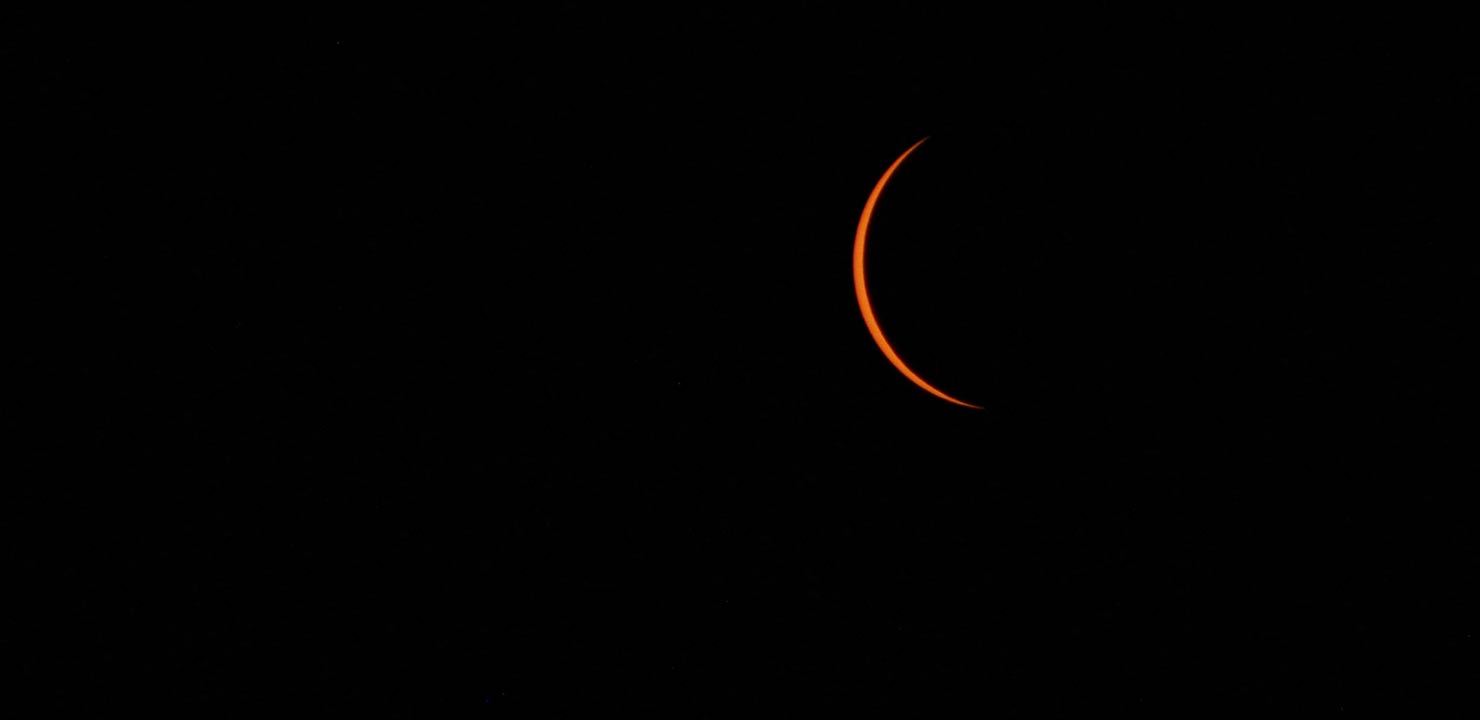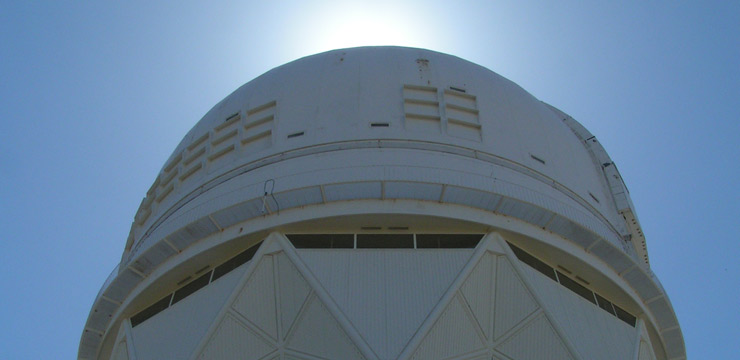
The Journey to Totality
February 2018 :
Today’s column is a departure from my monthly highlights of upcoming astronomical events. February’s lack of spectacular phenomena influenced my decision to recap last Augusts' solar eclipse. However, this story is more about the journey to the path of totality than it is about the eclipse itself.
Ever since I became interested in astronomy in the early 1970s I was aware of a total solar eclipse that would diagonally traverse the United States on August 21, 2017. But that date was a long way off, so I travelled to Manitoba, Canada in 1979 for the total solar eclipse of February 26, where about 2 minutes and 40 seconds of totality was observed. Thus bitten by the eclipse “bug,” I immediately signed on to a two-week eclipse/safari expedition to Tanzania, Africa in February, 1980. On February 16 about 3 minutes and 54 seconds of totality was successfully observed from Tarangire National Park, a game reserve. Other solar eclipses followed, including: a successfully observed annular eclipse from Greenville, South Carolina in May 1984; a clouded out total eclipse in Hawaii in July 1991; and a mostly clouded out view of annularity from Attitash, New Hampshire in May 1994.
As 2017 drew closer at hand I was a bit behind the eight ball. Planning for the 1991 Hawaii eclipse had begun three years prior to the event. However, I wasn’t necessarily worried about elaborate plans for the August 21 event, since the 71 mile-wide path stretched 2500 miles diagonally across densely populated regions of the United States from Oregon to South Carolina. But I should have been. While millions of people lived within totality’s path, millions more were looking to position themselves within that zone as well.
My wife Tina and I did not wish to fly, so I began to research suitable locations along the path that would be within a two-day drive. I decided on Hopkinsville, Kentucky. Since this city would experience the longest duration of totality along the path, two minutes and forty seconds, everybody and their brother were also selecting this location. After a few phone calls and many follow-up emails, during June 2016, I was able to secure permission to observe the eclipse from the campus of Hopkinsville Community College (HCC). Now the challenge would be to find accommodations because most of the lodging establishments would not accept reservations until 11 months out.
However, I did contact a manager of one hotel chain in Hopkinsville. While he was not accepting reservations at the time, he told me they were considering charging $1000 per night and requiring a three night minimum stay! I sucked in so much air in shock that I made the room I was in a vacuum! He took my name and email address to communicate the specifics when they decided on the rate. (The eclipse was on a Monday, so they figured they would book rooms for Friday, Saturday and Sunday nights.)
I called around the area and everyone was following suit. Even accommodations 120 miles away were in the $500/night range with a three-night minimum. What to do? I would call it price gouging, but that definition only applies in emergency/disaster circumstances. Supply and demand would be a more appropriate term, though I saw it as pure and simple greed!
A good friend of ours suggested Airbnb, an online accommodations broker. I had heard of this enterprise before, but had never checked it out. After a short search of their offerings I found a “Couple’s Getaway/Writer’s Retreat” in Adams, Tennessee. And as luck would have it, the place was within the path of totality. In fact, the property would experience two minutes and 35.9 seconds of totality. And the price was right, only $175 per night. During the first week of August 2016 we booked four nights. (The lodging establishment in Hopkinsville eventually decided on $899/night with a three night minimum.)
Our wonderful hosts in Adams were Ray and Jo Lacroix. Come to find out, Ray used to live in Woonsocket, and had also lived in Burrillville, my home town. And his two sons live in nearby Glocester. It was simply meant to be!
As we got into 2017, our travel plans were finalized for the 1100 mile drive down to Adams. Then on Wednesday, March 29, our universe changed in an instant. My wife Tina had a major stroke. No warning signs … just BAM! When I was finally able to see her after surgery to remove the clot, she recognized me immediately. Her speech was only slightly slurred. Her memory was intact. Her left side was compromised. Tina could barely move her arm and leg, but at least had feeling on that side. She was unable to walk. Her left eyesight was also deficient. I’ve never felt so helpless in my life. But there was nothing I could do. She was in the capable hands of the staff at Rhode Island Hospital.
I had an astronomy lab to teach at Bryant that night. My students had studied for a quiz, and there was no way to get the quiz to campus on time. Tina was still under the effects of sedation, drifting in and out of consciousness. However, she was concerned about my lab. She insisted I teach my class as scheduled. It was a temporary distraction. When I arrived home after the lab I simply lost it. The house was empty and Tina wasn’t there as usual to ask me “how did the lab go tonight?”
The next day when I visited Tina, one of the first things she asked was, “How did the lab go last night?” That’s my Tina! She spent one week recovering at Rhode Island Hospital.
Tina’s next chapter to recovery was four weeks of rehab at the Rehabilitation Hospital of Rhode Island in North Smithfield. The fine group of therapists spent at least three hours per day helping Tina to recover the everyday tasks you and I take for granted. They worked on Physical Therapy, Speech Therapy (really cognitive/logic/memory therapy – Tina’s speech was fine), and Occupational Therapy.
Right from the beginning of her rehab Tina told the therapists of our eclipse expedition plans. She expressed that she would do anything towards attaining that goal. Every day that I visited her I would see improvement. She proved to be a very good patient. Her determination was unbelievable. Attitude is everything … well, at least in conjunction with the great work by the therapists. Eventually they had her using a walker to get around. She even briefly attempted a cane with close supervision before she was released.
On May 1 Tina came home. She had been away for five weeks. Within a week therapists from Concord Home Health and Wellness Services began in-homecare visits. They continued and expanded upon the progress Tina had already made. She used the walker for while, but soon began using the cane without assistance more frequently. She expressed her desire to the PT that we were still going to the eclipse and that she would use the cane, not the walker, if she had to. Tina was soon walking without the cane. (Note: Though we did bring the cane with us on our trip, she did not use it at all. In fact, all her therapists would be very proud of her. Two days before the eclipse we walked around downtown Hopkinsville, KY, where perhaps one hundred vendors were hawking anything eclipse themed. And on the day after the eclipse we walked most of Mammoth Cave. Both excursions Tina managed without the cane. What a trooper! I was very proud of what she had accomplished.)
During the first week of June my plan was to still drive about 40 minutes the morning of the eclipse up to Hopkinsville to observe with faculty of HCC. Unfortunately, the administration made some changes to their plans. Therefore we decided to observe right from our spot in Adams, only losing 4.1 seconds of totality. This change was the best thing that could have happened to our plans.

We arrived at Ray and Jo’s place in Adams, Tennessee on Friday evening, August 18. The walkout basement apartment was cozy with all the amenities. They treated us like family. On Monday, eclipse day, they provided us a barbecue before, during and after the eclipse. We wouldn’t have had that kind of hospitality at any of the other lodgings. Their two daughters, one son-in-law, one boyfriend, and two young children joined in the festivities. I brought several pair of eclipse glasses for them to use.
Fortunately there were no clouds in the vicinity. When the partial phase began the temperature was 93 degrees with extremely high humidity. I obtained a good series of partial phase images leading up to totality using a 300mm lens. Unfortunately when I removed my solar filter I inadvertently changed the focus, resulting in my totality images being slightly out of focus. See this link for some of these images: http://www.theskyscrapers.org/huestis-2017-eclipse. See this Youtube link for a short movie of totality taken by Ray’s son-in law Ryan:
When the Sun reappeared 2 minutes and 35.9 seconds later, it looked like an extremely bright arc light. I decided not to take outgoing partial images. During totality the temperature dropped 8 degrees from 93 to 85.
We were successful. Tina’s strong determination during recovery resulted in her observing her first total solar eclipse. Immediately afterwards we began talking about the April 8, 2024 total solar eclipse. Our stay with Ray and Jo is aptly summed up by a plaque on the wall of the basement apartment: “Arrive as friends. Leave as family.”
Tina has since gone back to work and continues toward her goal of full recovery.
Dave Huestis PS. We put 2660 miles on the Rogue!









Related Topics




